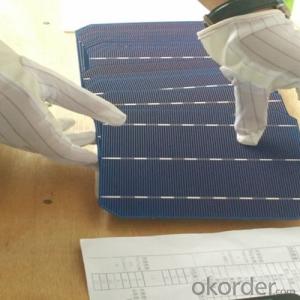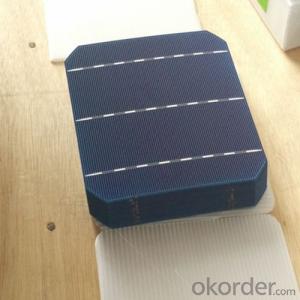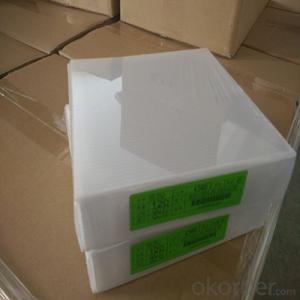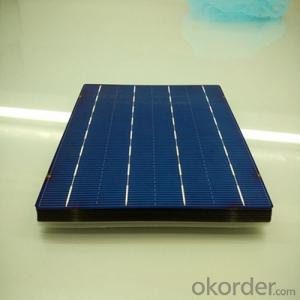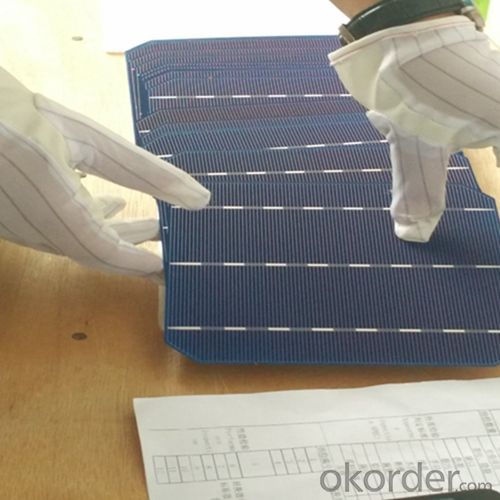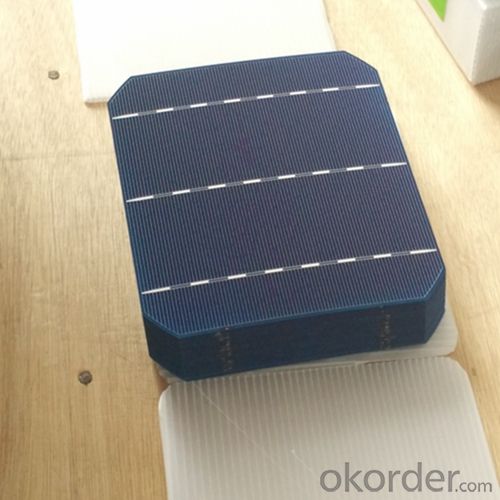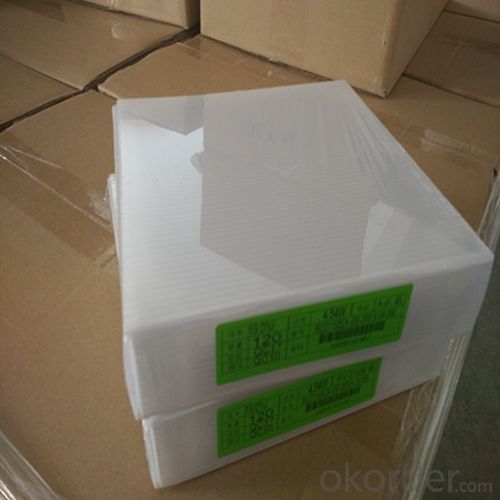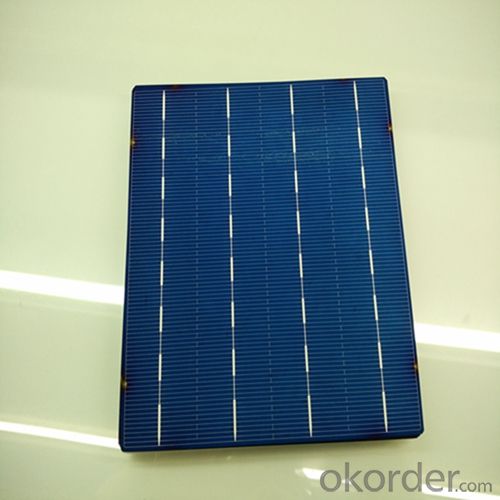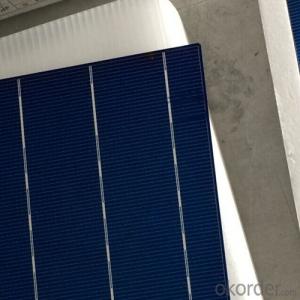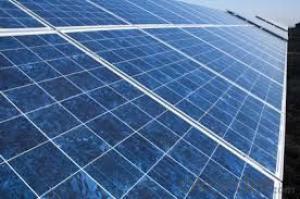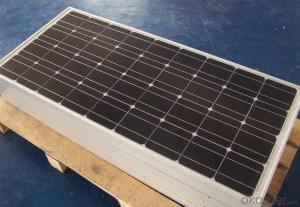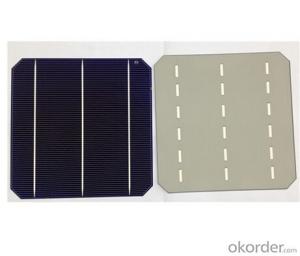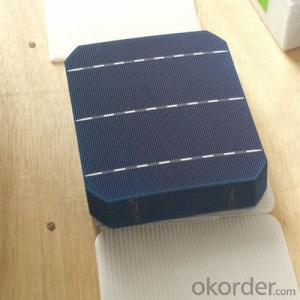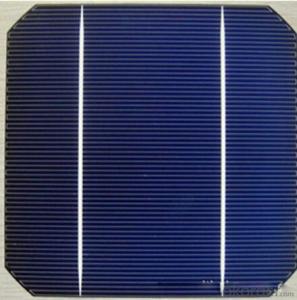Tj Solar Cells - Mono 156x156mm2 Solar Cells Made in China
- Loading Port:
- Shanghai
- Payment Terms:
- TT OR LC
- Min Order Qty:
- 4900 watt
- Supply Capability:
- 6000000 watt/month
OKorder Service Pledge
OKorder Financial Service
You Might Also Like
The operation of a photovoltaic (PV) cell requires 3 basic attributes:
The absorption of light, generating either electron-hole pairs or excitons.
The separation of charge carriers of opposite types.
The separate extraction of those carriers to an external circuit.
In contrast, a solar thermal collector supplies heat by absorbing sunlight, for the purpose of either direct heating or indirect electrical power generation from heat. A "photoelectrolytic cell" (photoelectrochemical cell), on the other hand, refers either to a type of photovoltaic cell (like that developed by Edmond Becquerel and modern dye-sensitized solar cells), or to a device that splits water directly into hydrogen and oxygen using only solar illumination.Characteristic of Mono 156X156MM2 Solar Cells
You are gaining energy independence - add battery backup power for even greater energy security
The cost of electricity is only going to rise – insure against that rising cost
Adaptive cells change their absorption/reflection characteristics depending to respond to environmental conditions. An adaptive material responds to the intensity and angle of incident light. At the part of the cell where the light is most intense, the cell surface changes from reflective to adaptive, allowing the light to penetrate the cell. The other parts of the cell remain reflective increasing the retention of the absorbed light within the cell.[67]
In 2014 a system that combined an adaptive surface with a glass substrate that redirect the absorbed to a light absorber on the edges of the sheet. The system also included an array of fixed lenses/mirrors to concentrate light onto the adaptive surface. As the day continues, the concentrated light moves along the surface of the cell. That surface switches from reflective to adaptive when the light is most concentrated and back to reflective after the light moves along
Mechanical data and design
Format | 156mm x 156mm±0.5mm |
Thickness | 210μm±40μm |
Front(-) | 1.5mm bus bar (silver),blue anti-reflection coating (silicon nitride) |
Back (+) | 2.5mm wide soldering pads (sliver) back surface field (aluminium) |
Temperature Coefficient of Cells
Voc. Temp.coef.%/K | -0.35% |
Isc. Temp.coef .%/K | +0.024%/K |
Pm.Temp.coef. %/K | -0.47%/K |
Electrical Characteristic
Effiency(%) | Pmpp(W) | Umpp(V) | Impp(A) | Uoc(V) | Isc(A) | FF(%) |
18.35 | 4.384 | 0.526 | 8.333 | 0.63 | 8.877 | 78.39% |
18.20 | 4.349 | 0.526 | 8.263 | 0.63 | 8.789 | 78.54% |
18.05 | 4.313 | 0.525 | 8.216 | 0.63 | 8.741 | 78.32% |
17.90 | 4.277 | 0.524 | 8.161 | 0.625 | 8.713 | 78.04% |
17.75 | 4.241 | 0.523 | 8.116 | 0.625 | 8.678 | 77.70% |
17.60 | 4.206 | 0.521 | 8.073 | 0.625 | 8.657 | 77.36% |
17.45 | 4.170 | 0.519 | 8.039 | 0.625 | 8.633 | 76.92% |
17.30 | 4.134 | 0.517 | 8.004 | 0.625 | 8.622 | 76.59% |
17.15 | 4.096 | 0.516 | 7.938 | 0.625 | 8.537 | 76.80% |
17.00 | 4.062 | 0.512 | 7.933 | 0.625 | 8.531 | 76.18% |
16.75 | 4.002 | 0.511 | 7.828 | 0.625 | 8.499 | 75.34% |
16.50 | 3.940 | 0.510 | 7.731 | 0.625 | 8.484 | 74.36% |
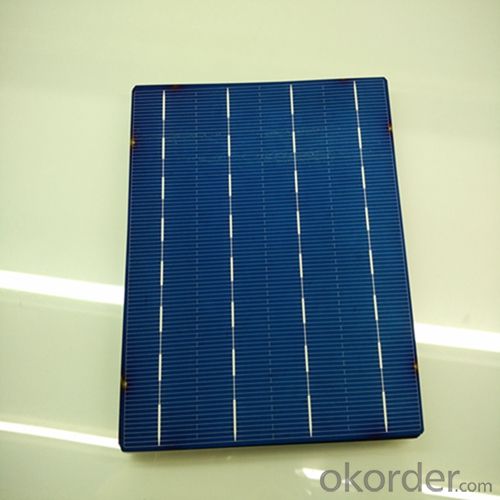
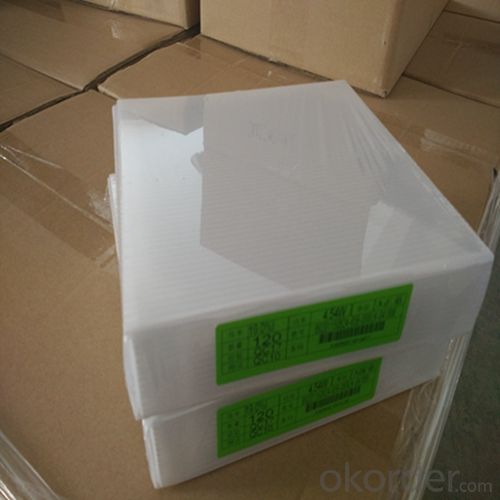
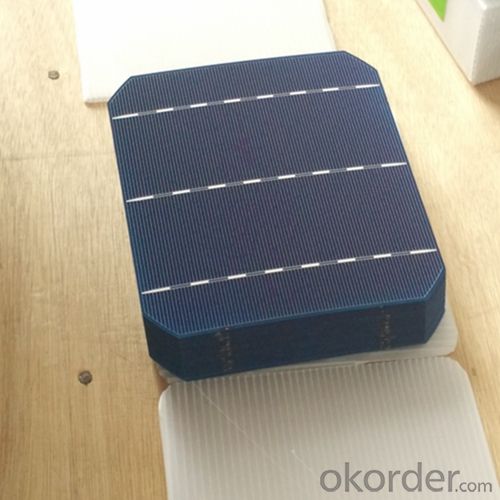
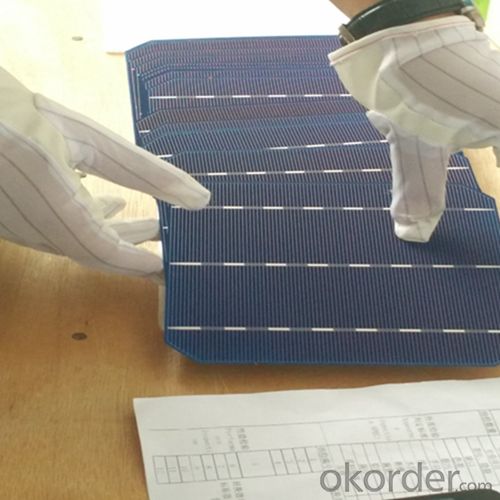
 FAQ
FAQ
Q: What price for each watt?
A: It depends on the quantity, delivery date and payment terms, generally Large Quantity and Low Price
Q: What is your size for each module? Can you tell me the Parameter of your module?
A: We have different series of panels in different output, both c-Si and a-Si. Please take the specification sheet for your reference.
Q: What is your size for each module? Can you tell me the Parameter of your module?
A: We have different series of panels in different output, both c-Si and a-Si. Please take the specification sheet for your reference.
- Q: What is the most common type of solar cell?
- The most common type of solar cell is the silicon-based solar cell.
- Q: What is a polycrystalline solar cell?
- A polycrystalline solar cell is a type of solar cell made from multiple crystal structures, resulting in a grainy appearance. It is less expensive to produce compared to monocrystalline cells, but typically has lower efficiency levels.
- Q: Can solar cells be used for powering streetlights?
- Yes, solar cells can be used for powering streetlights. Solar-powered streetlights are a sustainable and cost-effective solution that harnesses the energy from the sun using solar cells to generate electricity, making them independent of the power grid. This helps in reducing energy consumption and minimizing carbon emissions.
- Q: How long does it take to install solar cells on a residential property?
- The installation time for solar cells on a residential property can vary depending on factors such as the size of the system, complexity of the installation, and the experience of the installation team. However, on average, it usually takes around one to three days to complete the installation process.
- Q: Can solar cells be used for powering oil rigs?
- Yes, solar cells can be used for powering oil rigs. Solar panels can harness sunlight to generate electricity, which can be utilized to power various equipment and systems on oil rigs, reducing reliance on traditional fossil fuel-based generators and minimizing environmental impact. However, the feasibility and effectiveness of implementing solar power on oil rigs depend on factors such as energy requirements, geographic location, available space, and cost considerations.
- Q: Do solar cells work in cloudy weather?
- Yes, solar cells can still generate electricity in cloudy weather, although their efficiency may be reduced compared to clear, sunny conditions.
- Q: What is the most commonly used material for solar cells?
- It is mainly the crystalline silicon materials (including polysilicon and monocrystalline silicon), its market share in more than 90% and in the future for a long period of time will still be the main material of solar cells.
- Q: How do solar cells perform in snowy conditions?
- Solar cells do not perform as efficiently in snowy conditions because the snow cover blocks sunlight from reaching the cells. However, modern solar panels are designed to be durable and can still generate some electricity even in snowy conditions. Additionally, when the snow melts or is removed from the panels, they can resume their normal performance.
- Q: What is the efficiency of a solar cell?
- The efficiency of a solar cell refers to the percentage of sunlight it can convert into usable electricity.
- Q: How much electricity can a solar cell generate?
- The amount of electricity a solar cell can generate depends on various factors such as the size and efficiency of the cell, the intensity and duration of sunlight, and the environmental conditions. On average, a standard solar cell can generate around 1 to 2 watts of electricity per square meter under optimal conditions.
Send your message to us
Tj Solar Cells - Mono 156x156mm2 Solar Cells Made in China
- Loading Port:
- Shanghai
- Payment Terms:
- TT OR LC
- Min Order Qty:
- 4900 watt
- Supply Capability:
- 6000000 watt/month
OKorder Service Pledge
OKorder Financial Service
Similar products
Hot products
Hot Searches
Related keywords
